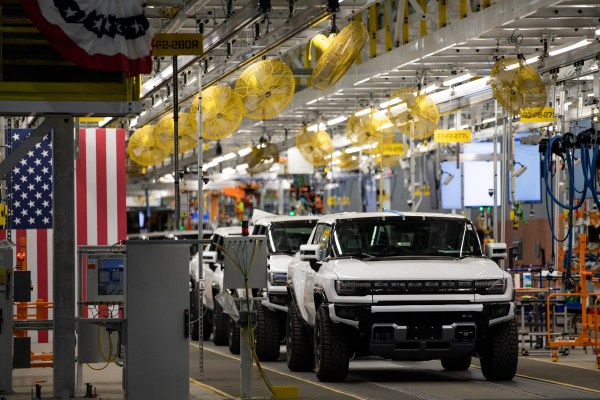[ad_1]
Vitality’s US division invests $15.5 billion in electrical autos

The US Division of Power is dedicating $15.5 billion to assist the transition to electrical autos.
President Joe Biden’s funding agenda in America features a vital $15.5 billion funding by the US Division of Power (DOE) to speed up the transition to electrical autos (EVs) and construct a powerful home manufacturing ecosystem. By offering monetary help, DOE goals to encourage automakers and suppliers to repurpose their crops to provide electrical, hybrid and hydrogen gasoline cell EVs. This strategic funding aligns with the administration’s goal of making high-paying manufacturing jobs throughout the nation.
Promoting Automotive Manufacturing Conversions
Nearly the entire funding, about $12 billion, will likely be allotted to automotive manufacturing conversion tasks for mild, medium and heavy-duty EVs. This funding could possibly be delivered by way of a mixture of a $2 billion grant and a $10 billion mortgage. By encouraging automobile producers and suppliers to transform their manufacturing capabilities, DOE goals to drive mass adoption of electrical autos and cut back reliance on conventional inner combustion engine autos.
Progress in home battery manufacturing
Along with supporting automobile producers, DOE will direct $3.5 billion towards rising home battery manufacturing. The funding will likely be targeted on establishing battery manufacturing companies and enhancing the nation’s grid infrastructure. Historically, battery provides and parts have been largely imported from varied nations, particularly China. Nonetheless, the disruptions attributable to the COVID-19 pandemic highlighted the necessity for extra self-sustaining provide chains. By investing in home battery manufacturing, the US can cut back its reliance on imports and create a safe and sustainable provide of battery supplies.
This funding for battery provide and manufacturing represents the second tranche of help supplied by DOE. This displays the federal government’s dedication to furthering the event of a powerful battery manufacturing enterprise within the US.
Onshoring Patterns and Inflation Exemption Act
An rising variety of automakers and battery producers have acknowledged the significance of constructing battery manufacturing amenities on American soil. The pattern towards onshoring accelerated because the pandemic disrupted international provide chains, making entry to crucial battery provides troublesome. The change is in keeping with the passage of the Inflation Rebate Act (IRA) in August 2022, which supplies vital incentives for home manufacturing. Nonetheless, steerage continues to be pending from the Treasury on quite a lot of initiatives contained in the IRA.
employment technology and selling monetary progress
The quite a few investments made by DOE in home EV and battery manufacturing are in keeping with the Biden administration’s imaginative and prescient of making high-paying manufacturing jobs for people. The presence of automotive manufacturing crops can stimulate native economies and supply good-paying jobs for communities. DOE will prioritize grants and funding for firms positioned in communities with a historical past of automotive manufacturing. Precedence may additionally be given to initiatives that resolve to pay greater wages to manufacturing staff and keep collective bargaining agreements.
conclusion
The US Division of Power’s $15.5 billion funding within the transition to electrical autos and home battery manufacturing is a crucial milestone within the nation’s effort towards a sustainable and self-sufficient automotive trade. By incentivizing automakers, suppliers and battery makers, DOE goals to speed up the adoption of electrical autos, enhance home manufacturing capabilities, and create high-paying jobs. This strategic funding underlines the federal government’s dedication to a cleaner, greener future whereas driving financial progress and resilience.
inquiries to ask
1. How a lot funding is the US Division of Power offering for the transition to electrical autos?
The US Division of Power is providing $15.5 billion to assist the transition to electrical autos.
2. The place will the majority of the funding be allotted?
Nearly the entire funding, about $12 billion, will likely be allotted to automotive manufacturing conversion tasks for light-, medium- and heavy-duty electrical autos.
3. What’s the focus of the $3.5 billion allocation?
The allocation of $3.5 billion will deal with establishing battery manufacturing companies and enhancing the nation’s grid infrastructure, in addition to rising home battery manufacturing.
4. Why is there a necessity for home battery manufacturing?
The disruptions attributable to the COVID-19 pandemic have highlighted the significance of self-sustaining provide chains for battery provides. By investing in home manufacturing, the US can cut back its reliance on imports and create a safe and sustainable provide of battery supplies.
5. How does the funding align with the objectives of the Biden administration?
The funding is in keeping with the Biden administration’s purpose of making high-paying manufacturing jobs throughout the nation, significantly in communities with a historical past of automotive manufacturing. The presence of automotive manufacturing crops can stimulate native economies and supply good-paying jobs for communities.
Please see this hyperlink for added info
[ad_2]
To entry extra info, kindly discuss with the next link